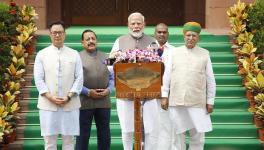COVID-19 – Lessons In Constitution And Governance
In light of the devastation of the current wave of COVID-19 that India is undergoing and the fault lines it has exposed in our governance system, AKHIL V. MENON and RASSAL JANARDHANAN A. analyse the crisis from the distinct prisms of the constitutional guarantee of the right to healthcare, the financial imbalance in the relations between the Centre and the states, and the Supreme Court’s role in supervising the management of this crisis and offer suggestions for strengthening our institutional resilience.
WE are currently facing a challenge, unprecedented in the history of the country. The pandemic has taken away countless precious lives and has left our nation gasping for breath. Once the pandemic recedes, it will leave a country that may be quite unknown to us, with deepened inequality. Furthermore, the pandemic has thrown up existential questions about our rights’ jurisprudence and institutional resilience.
It is imperative to address these core issues while we rebuild our nation from the devastating impact of the virus.
Right to healthcare as a constitutional guarantee
The greatest casualty of the pandemic has been our healthcare infrastructure. The pandemic has brought to attention systemic pre-existing issues like lack of physical infrastructure and human resources. While China, with an even higher population, responded with massive make-shift hospitals, our State has not been able to concurrently meet the need.
When we are registering an upward trend in COVID mortality and many of our hospitals are running perilously low on oxygen, it throws open the constitutional question: do we really enjoy a right to life?
Also read: COVID-19 Pandemic has Shown India Why Healthcare Reforms are Imperative
Article 21 of the Constitution of India includes a catena of rights under its ambit. In the year 1989, the concept of the right to health care was added as an integral part to the right to life by the landmark judgment in the case of Pt. Paramanand Katara v. Union of India (1989 SCR (3) 997), wherein the Supreme Court recognized emergency medical care as a part of Article 21.
Since then, the apex court has developed a robust health care jurisprudence. In the case of Paschim Banga Khet Mazdoor Samity v. State of West Bengal (1996 SCC (4) 37), the Supreme Court, in its judgment, observed that the Constitution envisages the establishment of a welfare state in which the primary duty of the government is to provide adequate medical facilities to the people.
This attempt to develop a health care jurisprudence in India is also in consonance with the obligation envisaged under Article 2(1) of the International Covenant on Economic, Social and Cultural Rights (ratified by India on 10th April 1979), wherein, the contracting states have a duty to ensure the progressive realization of social and economic rights.
However, critics of such an approach were quick to point out the financial incapacity of the state to deliver on economic rights, like the right to adequate healthcare. The judiciary itself attempted to address this issue in the matter of State Of Punjab v. Ram Lubhaya Bagga ((1998) 4 SCC 117). In its judgment, the Supreme Court held that the right to healthcare cannot be construed as absolute, as no State is supplied with unlimited resources, and the level to which this right can be achieved depends on the financial capacity of the State; hence, the State machinery cannot be blamed for not providing any facilities which are beyond its financial capacity.
India’s doctor-to-patient ratio of 1:1,456 is over 30 percent below the World Health Organization-mandated ratio of 1:1000. Furthermore, India’s total public health expenditure, at 1.29% of its gross domestic product is the lowest among all BRICS (Brazil, Russia, India, China, South Africa) nations. Moreover, the spending of several state governments on health has dropped in the last decade.
The present state of affairs paints a grim picture of our health care infrastructure. This poses the essential question: has the Supreme Court made any actual headway in expanding the horizons of Article 21 to include right to healthcare?
The inability of the Supreme Court in materially expanding its rights jurisprudence to ensure the minimum economic investment for its realization is rooted in the lack of periodic assessment of its own judgments. Therefore, many of its lofty declarations have remained only on paper, and its discourse restricted to the four walls of law colleges in the nation. One wonders how the judiciary can give teeth to its judgments.
Also read: Analyzing Supreme Court’s Attempt To Safeguard Right To Health
One way could be for the judiciary to initiate a periodic dialogue with the executive under the larger banner of ‘judicial impact assessment’ to effectively identify the steps taken by the State in pursuance of its jurisprudence, especially concerning Part III of the Constitution. This could lead to the mainstreaming of discussions around the executive’s role in ensuring the basic minimum financial investment in the realization of fundamental rights.
Such proactive role of the judiciary is essential in our quest towards a welfare state.
The Need for Fiscal Federalism
However, inadequate health care infrastructure cannot be addressed by the judiciary alone. It requires an overhaul at the legislative and policy levels. The Indian Constitution puts the onus for public health management on the state government (As per List II, Entry 6 of the Seventh Schedule of the Constitution). However, the real question is: are state governments financially capacitated to deliver on such obligations? The crisis faced by several state governments in spending on healthcare can be attributed to the lack of fiscal federalism in our country.
An analysis of financial relations between the Union and states reveals that there exist vertical imbalances between the two levels of government. This can be attributed to the extensive power of taxation under the Constitution granted to the Union with relatively lesser power given to states. The liberalisation regime deepened the inequalities among states, thus exacerbating horizontal imbalances. Furthermore, the limitations placed by the Article 293 of the Constitution on foreign borrowings by state governments, the restrictions imposed by the Fiscal Responsibility and Budget Management Act, 2003 (FRBM Act), reforms like the Goods and Services Tax, among other things, have put further curbs on the financial autonomy of state governments.
This lack of financial autonomy for states has led to poor infrastructure creation in many states. In a continent-sized country, any attempt at improving the social infrastructure should start from the roots, and state governments are best-equipped to deliver on these through the medium of local self-governments.
The pandemic points to a need to rework the current framework of our fiscal structure. Removing the limits of borrowing and relaxing the FRBM Act’s limits without any conditionality are some steps which can be taken in the short and medium term.
In the long term, states must be given more power to create their own resources. Further, their power of taxation and claims to the divisible pool should reflect the constitutional obligations placed on various levels of government.
Also read: GST Imbroglio and the Angst of States Battling Financial Crunch and COVID-19
Supreme Court’s role in crisis governance
The right to health will remain a work in progress for some time. Our immediate priority is the effective management of the pandemic.
It is often argued by the State that constitutional courts cannot play a constructive role in a situation as complex and worrying as this, and it is best to trust the executive wisdom.
Of course, it is not up to the Supreme Court to substitute its wisdom for that of the executive. However, it should also not remain as a mute spectator, a description ascribed to it in the wake of the migrant crisis which erupted during the national lockdown in India last year. Consequently, the initial response of the Supreme Court in the pandemic did not justify its role as the protector of the fundamental rights of citizens.
It should be noted that several High Courts have fared better in crisis governance. For example, the recent interventions of the High Courts of Delhi and Madhya Pradesh to ensure the steady supply of oxygen in their states are laudable.
The second wave of COVID-19 has brought the Supreme Court another opportunity for redemption. Fortunately, its recent intervention shows promise in setting a precedent in crisis governance. The apex court has repeatedly questioned the State with respect to the rationale of its vaccination policy and its state-wise allocation of oxygen, among other things. This open exchange between the executive and the judiciary is visible in the order passed by the Supreme Court on 27th April 2021. The intervention assumes importance in ensuring transparency and accountability of executive actions in crisis governance.
Also read: Why Courts are justified in making correctional interventions during the pandemic
The Supreme Court can act as a forum for the collective exercise of our democratic right to know in these unprecedented times. Furthermore, in the absence of a well-functioning Parliament and an organised opposition, the Supreme Court must reinvent its role, albeit temporarily, to ensure crisis-governance committed to tenets of constitutionalism.
The pandemic has brutally exposed the fault lines in our governance system, and the need to improve the effective realization of our basic rights. Our institutional resilience will prove to be crucial in our way back towards the new normal. The crisis presents an opportunity for course correction on several fronts, and to build a nation rooted in constitutional ethos.
As Haruki Murakami wrote in his book ‘Kafka on the Shore’:
“And once the storm is over, you won’t remember how you made it through, how you managed to survive. You won’t even be sure, whether the storm is really over. But one thing is certain. When you come out of the storm, you won’t be the same person who walked in. That’s what this storm’s all about.”
Let us hope that as a nation, we emerge out of this pandemic with organised and effective institutions, and with a renewed focus towards an equal society with basic guaranteed rights for all citizens.
The article was originally published in The Leaflet.
(Akhil V. Menon and Rassal Janardhanan A. are both advocates based in Kerala, and graduates from the National University of Advanced Legal Studies, Kochi. The views expressed are personal.)
Get the latest reports & analysis with people's perspective on Protests, movements & deep analytical videos, discussions of the current affairs in your Telegram app. Subscribe to NewsClick's Telegram channel & get Real-Time updates on stories, as they get published on our website.
























